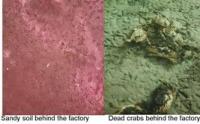Water Pollution is affecting aquatic and marine life, causing the death of many.
By Yankuba Jallow and Hatab Nyang
Bolongfenyoto is the Lagoon that serves as a demarcation between the Gambia and Senegal, on the southern border of the country. It is used for fishing by tourists and natives alike, and many wild animals can be found there as well. This is why many lodges and motels are built along its long shores to attract tourists and other visitors.
When visited by these reporters on May 25, 2017, many marine organisms were found dead on the shores of the Gunjur Lagoon (Bolongfenyoto). It was observed that the water by the shores of the Lagoon was also reddish in colour and covered with foam.
The organisms include crabs, mangroves and many other sea creatures. Many dried mangrove plants were also seen dried up, due to the change in water. Several crabs were also seen dead and scattered on the shores.
The Lagoon is used by herdsmen for their cattle to drink, whilst some use it for swimming purposes. It is said that about five people have acquired skin problems due to the present waters of the lagoon.
Speaking to a resident living by the shores of the lagoon, she said she often swims there everyday day after cooking but now she does not because her body developed pimples from the polluted water, which caused her to scratch her whole body. She further said she has been residing there for many years but since a fish meal company started operation, the water became polluted, adding that at midday the water darkens, which she said has never happened prior to the establishment of the company. Pimples could be seen all over her body.
Musa Taal has the worst skin problem than all the five people who were met by these reporters. He said he does sleep at night because of the itches of the pimples. He added that he acquired this from the Lagoon where he swims.
Badara N. Barjoe, the Director of Environmental Protection and Development Group, said the pollution seriously affects tourism in Gunjur. He said tourists do not come to Gunjur now; that even the wild birds do not frequent the area now because of the polluted water.
He said the reserve called Fabadinka along the lagoon, has many importance including biodiversity, and the location is an attractive and breeding ground for aquatic animals and mangrove; that the area serves as a tourist attraction because of the wild birds, crocodiles and many species of animals, that are in the area.
He said the reserve is unique because of its richness in biodiversity; that most of the endangered species and other animals, can be found in the reserve site that also serves as a tourist attraction for the country. He added that students use the reserve for research to learn about plants and animals that are endangered. He decried that the site faces a severe environmental degradation. “The industrial waste from the Company has been dumped in the water,” he said.
He added that he has been in the reserve land since 1997 and the water colour has never changed and there has never been any massive death of aquatic organisms like this. He also said the death of aquatic organisms started on or about May 21, 2017, because of the toxic water condition, which he said worries him.
**See the next edition for the comment of the fish meal factory on the issue.

